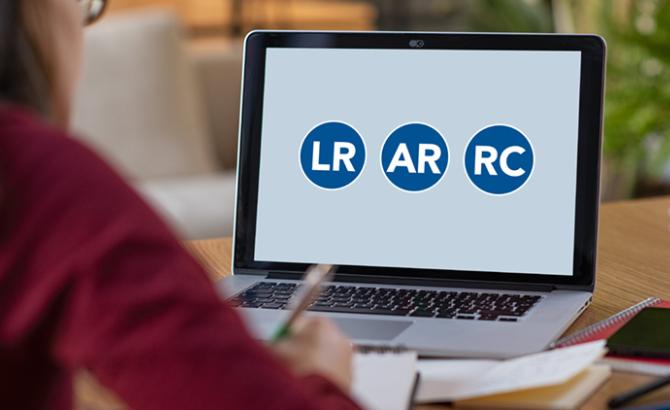The LSAT Is Still the Most Accurate Predictor of Law School Success
As a result of the pandemic, the major undergraduate admission testing organizations canceled several administrations of their tests, and many prospective test takers were left with few if any opportunities to test. Unlike the Law School Admission Council (LSAC), these testing organizations were unable to pivot to at-home testing via remote proctoring. This lack of access to testing led many colleges to suspend the requirement for a standardized admission test for applicants this year. It’s not surprising, then, that critics of standardized tests have seized this opportunity to argue that these tests are no longer necessary.
But does all of the attention that is being paid to test-optional undergraduate admission policies have any bearing on law school admission? To answer this question, it’s important to first understand that the role that the Law School Admission Test (LSAT) plays in law school admission is quite different from the role that undergraduate admission tests play in college admissions. Table 1 compares the adjusted correlations of college applicants’ test score and high school GPA (HSGPA) with college freshman GPA, as well as the adjusted correlations of LSAT score and UGPA with first-year average (FYA, or 1L GPA) in law school.
Table 1: Adjusteda Correlations: Test Scores and Prior Grades with Subsequent Grades
|
Test |
Prior Gradesb |
Test + Grades |
% Increase in Correlation w/Testc |
% Increase in Correlation w/Grades |
|
|---|---|---|---|---|---|
|
SAT, HSGPA |
.51 |
.53 |
.61 |
15% |
20% |
|
ACT, HSGPA |
.51 |
.61 |
.64 |
5% |
25% |
|
LSAT, UGPA |
.60 |
.42 |
.66 |
57% |
10% |
aAdjusted for restriction of range in predictor.
b College freshman GPA used in SAT study. First-year GPA in law school used in LSAT study (in preparation).
c The percent increase in correlation with the addition of test scores is calculated by dividing the correlation of grades (.53 for SAT) into the correlation for grades and tests (.61) and subtracting 1 from the sum (1.15–1 = 15%). A similar process is used to calculate the percent increase in correlation with the addition of grades to test scores.
HSGPA = high school GPA; LSAT = average LSAT score; UGPA = undergraduate GPA
Table 1 shows that LSAT scores are significantly stronger in predicting academic success in law school compared to either SAT or ACT scores in predicting undergraduate success. For undergraduate programs, prior grades have consistently been better than test scores in predicting subsequent academic success. However, undergraduate grades are weaker predictors of law school grades, whereas the LSAT is far superior in predicting academic success in law school. In fact, adding LSAT score to UGPA improved prediction by 57%. By contrast, adding SAT or ACT scores to HSGPA improved prediction by only 15% and 5%, respectively. These findings are generally consistent across law schools irrespective of region and selectivity, with 83% of schools meeting or exceeding an adjusted correlation of .60 between LSAT score and 1L GPA in 2020.
Predictive validity is generally the most direct and relevant type of evidence used to support admission practices; 1L GPA is generally used as a criterion because first-year coursework is more likely to be similar across programs, and performance in the first year is highly correlated with graduation. Nevertheless, external studies have demonstrated a strong relationship between LSAT score and factors beyond 1L GPA, such as class rank at graduation and performance on the bar exam.[1]
The predictive validity of LSAT score for 1L GPA is strong (Figure 1)—undoubtedly due to the fact that the LSAT measures skills that are specifically required for success in law school. This fact is supported by several surveys of law faculty that demonstrate that the most important foundational skills for success in law school are those that are assessed on the LSAT.[2] This evidence provides a second type of validation evidence to support the use of LSAT: content validity. In short, the LSAT has content validity because the skills it assesses are those most important for law school success, and it does not test skills that are not relevant to the law school curriculum.
Figure 1: Adjusted Correlations: LSAT and UGPA with 1L GPA

Some critics of testing have argued that tests such as the LSAT may not measure many skills required on the job or may not predict career success. There are several rebuttals to this argument. The purpose of the LSAT is to assist admission leaders by predicting success in law school, and as demonstrated in the studies described above, the LSAT is highly successful in doing so. Law school is expected to prepare its students for the practice of law; both grades earned during law school and bar exam performance are more directly relevant to success in the law profession. In fact, it would be inappropriate to use the LSAT—a test administered prior to entry into law school—as a measure of competence or skill in the practice of law for those who have not yet had any training in the law.
The Grades-Based Acceptance Alternative
The findings summarized above show that prior grades are a relatively weak predictor of law school grades (see Table 1). They also show that LSAT score is a strong predictor of law school grades and that law school admission based on grades alone would introduce more unreliability into law school admission than a similar approach introduces to admission for undergraduate programs.
One reason that prior grades add less value in predicting law school success is that they correlate less well with 1L GPA (.42 adjusted correlation). There is substantial restriction of range in UGPA among law school applicants: Most applicants have high UGPAs, and thus there is less differentiation among applicants than may be the case for applicants to undergraduate programs. Stated another way, UGPAs often fall into too narrow a range to be very useful in making admission decisions.
Basing decisions primarily on grades doesn’t help differentiate among applicants when there are fewer seats available than applicants with a high UGPA. In addition, exclusive reliance on college grades as a predictor of academic success (i.e., a test-optional policy) would result in other detrimental effects:
- It would decrease representation of African American students, since the Black/white gaps found in LSAT scores are nearly identical to the large gaps found in UGPAs.[3]
- Likewise, all other things being equal, choosing a student with a UGPA of 4.3 above a student with a UGPA of 4.2, for example, would ignore the error present in grades as well as the differences found in grading scales across institutions and majors.
- Finally, using UGPA as the only metric would result in even greater pressure on faculty to inflate grades.
Clearly, relying exclusively on grades-based acceptance isn’t the answer.
The LSAT Should Be Used for Its Intended Purpose
Many criticisms of standardized tests are not leveled at their use for their intended purpose but are aimed instead against additional uses that were never intended or sanctioned. The same is true for the LSAT: The LSAT is intended to assist law schools in making admission decisions informed by the likelihood that the applicant will succeed in law school—most immediately, by predicting 1L GPA. Studies have also shown that LSAT score and UGPA, individually and in combination, are predictive of cumulative law school GPA to approximately the same degree as they are predictive of 1L GPA. That is, LSAT score predicts cumulative law school GPA about as well as it predicts 1L GPA; in both cases, LSAT score is superior to UGPA as a predictor. However, 1L GPA is a stronger predictor of cumulative law school grades than either LSAT score or UGPA. This fact should not be a surprise, nor is it a legitimate criticism of using LSAT scores in admission. It simply reinforces what we know to be true—viz., that LSAT score is the single best predictor of academic success in law school available to admission professionals.
Similarly, some observe that cumulative law school grades are a stronger predictor of bar exam passage than LSAT score. Again, this is not a surprising result, since the LSAT was designed to measure critical skills that were developed prior to matriculation and that are required for success in law school. It is also consistent with the intended use of the LSAT—that the test be used for admission decisions and not for predicting bar passage. What may be surprising is that LSAT score is reasonably correlated with bar passage, even though the scores are based on tests often administered four years earlier and well before students have matriculated into law school.
Conclusion
For more than 70 years, U.S. law schools have required the LSAT for admission. The reason is clear: Research consistently confirms that the LSAT is the single best predictor of law school success. Overall, LSAT scores provide a reliable and valid measure for law schools to use as one component of the admission process—information that cannot be adequately addressed solely by the use of college grades or other admission factors. Research reinforces the value and utility of the LSAT in finding that:
- Although HSGPA may be the best single predictor for college freshman GPA, LSAT score is the best single predictor for law school success. Combining LSAT score with UGPA improves prediction of 1L GPA by 57%, compared to using UGPA alone.
- The advantage of LSAT score over UGPA in terms of predictive validity increases at higher score levels and accounts for 65% of the prediction of 1L GPA at the 75th percentile. This means that the predictive validity of LSAT score increases for those schools that restrict consideration to a narrow (high) range of UGPAs.[4]
- Over the past decade, there has been an increase in the predictive validity of LSAT score (+.05–.06), with a small decrease (−.02) in the predictive validity of UGPA.[5]
- Test-optional policies reduce predictive validity in undergraduate admissions by about 15%, but the reduction in predictive validity for law school admissions would be four times greater (nearly 60%).
[1] Alphran et al. (2011), Austin et al. (2017), Georgakopoulos (2013), Marks & Moss (2016), Thomas, (2003), Wightman (1998).
[2] Walzer et al. (2019).
[3] We will explore this topic in depth in a forthcoming article.
[4] Law School Admission Council. Summary of 2017, 2018, and 2019 LSAT Correlation Study Results.
[5] Ibid.
References
Alphran, D., Washington, T., & Eagan, V. (2011). Yes we can, pass the bar: University of the District of Columbia, David A. Clarke School of law bar passage initiatives and bar pass rates—from the Titanic to the Queen Mary! University of the District of Columbia Law Review, 14(1), 9–39.
Austin, K. A., Christopher, C. M., & Dickerson, D. (2017). Will I pass the bar exam?: Predicting student success using LSAT scores and law school performance. Hofstra Law Review, 45(3), 753–784.
Camilli, G., Dustman, K., & Gallagher, A. (2020). Changes in undergraduate grade point averages across years of school (LSAC Research Report, RR 20-01). Law School Admission Council.
Georgakopoulos, N. L. (2013). Bar passage: GPA and LSAT, not bar reviews. Indiana University Robert H. McKinney School of Law Research Paper No. 2013-30. doi: 10.2139/ssrn.2308341
Law School Admission Council (2021). Summary of 2017, 2018, and 2019 LSAT Correlation Study results. Law School Admission Council. https://www.lsac.org/data-research/research/summary-2017-2018-and-2019-lsat-correlation-study-results
Marks, A. B., & Moss, S. A. (2016). What predicts law student success? A longitudinal study correlating law student applicant data and law school outcomes. Journal of Empirical Legal Studies, 13(2), 205–265.
Merritt, D. J. (2015). LSAT scores and eventual bar passage rates. The Faculty Lounge. https://www.thefacultylounge.org/2015/12/lsat-scores-and-eventual-–bar-passage-rates.html
Thomas, D. A. (2003). Predicting law school academic performance from LSAT scores and undergraduate grade point averages: A comprehensive study. Arizona State Law Journal, 35, 1007–1028.
Walzer, M., Dustman, K., Langer, D., Hegarty, M., Camilli, G., & Gallagher, A. (2019). LSAC 2018 Skills Analysis Study: Content validity of the LSAT (LSAC Research Report, RR 19-01). Law School Admission Council.
Westrick, P. A. , Marini, J. O., Young, L., Ng, H., Shmueli, D., & Shaw, E. J. (2019). Validity of the SAT for predicting first-year grades and retention to the second year. College Board.
Westrick, P. A., Schmidt, F. L., Le, H., Robbins, S. B., & Radunzel, J. M. R. (2021). The road to retention passes through first year academic performance: A meta-analytic path analysis of academic performance and persistence. Educational Assessment, 26(1), 35–51.
Wightman, L. F. (1998). LSAC National Longitudinal Bar Passage Study. Law School Admission Council.
Wightman, L. F. (1999). Beyond FYA: Analysis of the utility of LSAT scores and UGPA for predicting academic success in law school (LSAC Research Report, RR 99-05). Law School Admission Council.



